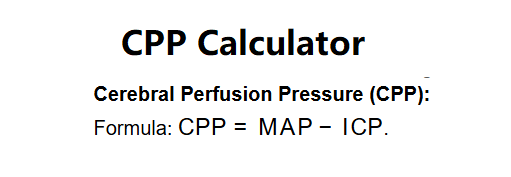 Home
Home
 Back
Back

Definition: This calculator computes the Cerebral Perfusion Pressure (CPP), a measure of the pressure gradient driving blood flow to the brain. It uses Mean Arterial Pressure (MAP), Intracranial Pressure (ICP), and age to calculate CPP and classify the result.
Purpose: CPP is critical in assessing brain perfusion, especially in patients with traumatic brain injury, stroke, or other neurological conditions. It helps clinicians ensure adequate cerebral blood flow to prevent ischemia or hyperperfusion.
The calculator takes MAP, ICP, and age with selectable units for pressure and computes:
Unit Conversions:
Steps:
Calculating CPP is useful for:
| Age Group | Normal CPP Range (mmHg) |
|---|---|
| 0–5 years old | 30–40 |
| 6–11 years old | 35–50 |
| 12–17 years old | 50–60 |
| 18 years and older | 60–80 |
Examples:
Q: What does CPP indicate?
A: CPP represents the pressure gradient driving cerebral blood flow. Normal ranges vary by age: 0–5 years (30–40 mmHg), 6–11 years (35–50 mmHg), 12–17 years (50–60 mmHg), 18+ years (60–80 mmHg).
Q: How are MAP and ICP measured?
A: MAP is typically derived from blood pressure readings (MAP = DBP + 1/3(SBP - DBP)), and ICP is measured via invasive methods like an intracranial catheter in clinical settings.
Q: What happens if CPP is too low or too high?
A: Low CPP can lead to cerebral ischemia (insufficient blood flow to the brain), while high CPP may cause hyperperfusion, potentially leading to brain edema or hemorrhage.